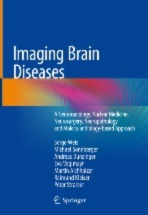상세정보
Imaging Brain Diseases A Neuroradiology, Nuclear Medicine, Neurosurgery, Neuropathology and Molecular Biology-based Approach [electronic resource]
Weis, Serge
- 책이미지
-
- 도서 상세정보
- 서평쓰기
| 자료유형 | 단행본 |
|---|---|
| 개인저자 | Weis, Serge.,author. Sonnberger, Michael.,author. Dunzinger, Andreas.,author. Voglmayr, Eva.,author. Aichholzer, Martin.,author. Kleiser, Raimund.,author. Strasser, Peter.,author. |
| 단체저자명 | SpringerLink (Online service). |
| 서명/저자사항 | Imaging Brain Diseases [electronic resource] : A Neuroradiology, Nuclear Medicine, Neurosurgery, Neuropathology and Molecular Biology-based Approach / by Serge Weis, Michael Sonnberger, Andreas Dunzinger, Eva Voglmayr, Martin Aichholzer, Raimund Kleiser, Peter Strasser. |
| 판사항 | 1st ed. 2019. |
| 형태사항 | LII, 2284 p. 893 illus., 725 illus. in color:online resource. |
| 기본자료 저록 | Springer Nature eBook |
| 기타형태 저록 | Printed edition:9783709115435Printed edition:9783709115459 |
| ISBN | 9783709115442 |
| 기타표준부호 | 10.1007/978-3-7091-1544-2 |
| 내용주기 | Part I. The techniques -- 1. Imaging modalities - Radiology -- 1.1. CT -- 1.2. MR Imaging -- 1.3. MR Spectroscopy -- 1.4. Perfusion imaging -- 1.5. Diffusion-weighted imaging (DWI) -- 1.6. Diffusion Tensor Imaging (DTI) -- 1.7. Functional MRI (fMRI) -- 2. Imaging modalities - Nuclear Medicine -- 2.1. SPECT -- 2.2. PET - [11 C]-Methionine (MET) -- 2.3. PET - [18 F]-Fluordeoxyglucose (FDG) -- 2.4. PET - [18 F]-Fluorethyltyrosine (FET) -- 2.5. PET - [18 F]-Fluorothymidine (FLT) -- 2.6. PET - [18 F]-Fluorodihydroxyphenylalanine (DOPA) -- 3. Imaging Modalities - Neuropathology -- 3.1. Gross-anatomy -- 3.2. Histology -- 3.3. Immunohistochemistry -- Part II. The normal human brain -- 4. The normal human brain -- 4.1. Subdivisions of the nervous system -- 4.2. Gross-anatomy of the nervous system -- 4.3. Ventricular system – Cerebrospinal fluid – Barriers -- 4.4. Meninges -- 4.5. Histological constituents of the nervous system -- 4.6. Microscopical built-up of the nervous system -- 4.7. Functional systems -- 5. Vascular supply of the brain -- 5.1. Arterial supply -- 5.2. Venous drainage -- Part III. The brain diseases – Edema and Hydrocephalus -- 6. Brain edema -- 7. Hydrocephalus -- Part IV -- The Brain diseases – Vascular system -- 8. Vascular disorders – Hypoxia -- 9. Vascular disorders – Ischemic lesions -- 10. Vascular disorders – Hemorrhage -- 11. Vascular disorders – Angiopathies -- Part V. The brain diseases – Infections -- 12. Infections – Bacteria -- 13. Infections – Viruses -- 14. Infections – Parasites -- 15. Infections – Fungi -- 16. Prion diseases -- Part VI. The brain diseases – Aging and neurodegeneration -- 17. Normal aging brain -- 18. Neurodegenerative disorders - Alzheimer's disease -- 19. Neurodegenerative disorders – Lewy body disease -- 20. Neurodegenerative disorders – Fronto-temporal lobe dementia -- 21. Neurodegenerative disorders – Multi-infarct dementia -- 22. Neurodegenerative disorders – Binswanger disease -- 23. Neurodegenerative disorders – Progressive supranuclear palsy -- 24. Neurodegenerative disorders - Parkinson's disease -- 25. Neurodegenerative disorders – Amyotrophic lateral sclerosis -- 26. Neurodegenerative disorders – Huntington disease -- Part VII. The brain diseases – Myelin disorders -- 27. Demyelinating diseases – Multiple Sclerosis -- 28. Neuromyelitis optica -- 29. ADEM -- Part VIII. The brain diseases – Epilepsy -- 30. Temporal lobe epilepsy -- 31. Cortical dysplasia -- Part IX. The brain diseases – Tumors -- 35. Tumors of the nervous system – General considerations -- 36. Tumors – Astrocytoma WHO II – Anaplastic Astrocytoma WHO III -- 37. Tumors – Glioblastoma WHO IV -- 38. Tumors – Gliosarcoma WHO IV – Giant cell Glioblastoma WHO IV -- 39. Tumors – Pilocytic astrocytoma WHO I -- 40. Tumors – Oligodendroglioma WHO II – Anaplastic oligodendroglioma WHO III -- 41. Tumors – Oligo-astrocytoma WHO II – Anaplastic Oligo-Astrocytoma WHO III -- 42. Ependymal tumors -- 43. Choroid plexus tumors – Papilloma – Carcinoma -- 44. Neuronal and mixed neuronal-glial tumors -- 45. Pineal parenchymal tumors -- 46. Embryonal tumors -- 47. Tumors of cranial and spinal nerves – Schwannoma -- 48. Tumors of cranial and spinal nerves – Neurofibroma -- 49. Tumors of cranial and spinal nerves – Perineuroma -- 50. Tumors of cranial and spinal nerves – Malignant peripheral nerve sheath tumor (MPNST) -- 51. Tumors of meningothelial cells -- 52. Mesenchymal, non-meningothelial tumors -- 53. Lymphomas and haematopoetic neoplasms -- 54. Germ cell tumors -- 55. Cysts and tumor-like lesions -- 56. Tumors of the sellar region -- 57. Metastatic tumors -- 58. Paraneoplastic syndromes – Autoimmune diseases -- 59. Radiation injury. |
| 요약 | This book illustrates in a unique way the most common diseases affecting the human nervous system using different imaging modalities derived from radiology, nuclear medicine, and neuropathology. The features of the diseases are visualized on computerized tomography (CT)-scans, magnetic resonance imaging (MRI)-scans, nuclear medicine scans, surgical intraoperative as well as gross-anatomy and histology preparations. For each disease entity, the structural changes are illustrated in a correlative comparative way based on the various imaging techniques. The brain diseases are presented in a systematic way allowing the reader to easily find the topics in which she or he is particularly interested. In Part 1 of the book, the imaging techniques are described in a practical, straightforward way. The morphological built-up of the normal human brain and its vascular supply are presented in Part 2. The chapters of the subsequent Parts 3 to 10 deal with the following diseases involving the nervous system including: hemodynamic, vascular, infectious, neurodegenerative, demyelination, epilepsy, trauma and intoxication, and tumors. The authors incite the clinician to see the cell, the tissue, the organ, the disorder by enabling him to recognize brain lesions or interpreting histologic findings and to correlate this knowledge with molecular biologic concepts. Thus, this book bridges the gap between neuro-clinicians, neuro-imagers and neuro-pathologists. The information provided will facilitate the understanding of the disease processes in the daily routine work of neurologists, neuroradiologists, neurosurgeons, neuropathologists, and all allied clinical disciplines. |
| 일반주제명 | Nervous system—Radiography. Neurology . Nuclear medicine. Pathology. Nervous system—Surgery. Neuroradiology. Neurology. Nuclear Medicine. Pathology. Neurosurgery. |
| 바로가기 | URL |





